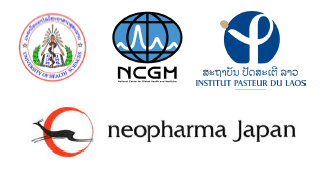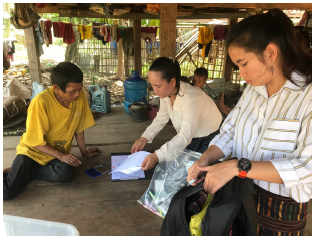5-Aminolevlinic acid asymptomatic malaria project
 Double-blind, parallel, randomized, placebo-controlled research to evaluate safety and efficacy of the 5-aminolevulinic phosphate (5-ALA PO4), sodium ferrous citrate (SFC) and zinc (Zn) with asymptomatic malaria parasite carriers
Double-blind, parallel, randomized, placebo-controlled research to evaluate safety and efficacy of the 5-aminolevulinic phosphate (5-ALA PO4), sodium ferrous citrate (SFC) and zinc (Zn) with asymptomatic malaria parasite carriers
Principal Investigator in Lao PDR: Dr. Mayfong Mayxzy, University of Health Sciences (UHS), Lao PDR
Principal Investigator in Japan: Dr. Shigeyuki Kano, IPL and National Center for Global Health and Medicine (NCGM), Japan
 Staff members in Parasitology Lab:
Staff members in Parasitology Lab:
Dr. Moritoshi Iwagami, Dr. Phonepadith Kahttignavong, Dr. Sengdeuane Keomalaphet, Dr. Phoyphaylinh Prasayasith, Ms. Pheovaly Soundala, Ms. Sonesimmaly Sannikone, and Mr. Takashi Sekine
Background
Recently, the Lao Ministry of Health adopted a goal to achieve the elimination of malaria by 2030. However, several studies demonstrated that there were asymptomatic Plasmodium carriers (hidden malaria, parasite reservoir) in the malaria-endemic areas in Lao PDR [1-3]. Most of them were adult populations who had histories of malaria episodes and were engaged in forest-related occupations [1]. Some studies also suggested that asymptomatic Plasmodium carriers can be a reservoir for transmission of malaria by Anopheles mosquitos. However, such people will never take any antimalarial medicines until they become symptomatic. In addition, most asymptomatic Plasmodium infections cannot be detected by standard diagnostic methods that are available in the endemic areas (microscopy and RDT). The current malaria control and elimination strategy in Lao PDR target only symptomatic malaria patients. Therefore, to accelerate the elimination of malaria in Lao PDR, a new effective strategy for targeting asymptomatic Plasmodium carriers is urgently needed in the endemic areas. It was found in pre-clinical studies that sodium ferrous citrate (SFC) enhanced the P. falciparum-killing potency of 5-ALA and significantly inhibited the parasite growth both in vitro and in vivo [4,5]. These novel findings may lead us to develop a new functional health supplement containing antimalarial activity using 5-ALA. In addition, 5-ALA is being sold as a health food supplement, which has the functional claim “5-ALA supports to bring higher fasting blood glucose levels closer to normal” in Japan [6,7]. In this study, we will evaluate the acceptability, safety and efficacy of 5-ALA phosphate (PO4) with SFC and Zn supplements for the treatment of asymptomatic Plasmodium carriers in malaria-endemic villages, Nong and Sepon districts, Savannakhet province, Lao PDR for one year.
The efficacy of 5-ALA PO4 to control Plasmodium infection will be examined by reduction of Plasmodium DNA positivity rate by PCR, compared to that of a Placebo group (only SFC and Zn). Since Zn deficiency is also a serious health problem in Lao PDR, participants of this study will take Zn as well to give a benefit for the study participants. It is reported that type 2 diabetes increases the risk for malaria infection [8]. Therefore, in addition to evaluating the efficacy of 5-ALA PO4 in Plasmodium infection control, we will also evaluate the level of HbA1c, which is one of the markers of type 2 diabetes. Expected outcomes will contribute to malaria elimination as well as type 2 diabetes control in Lao PDR.
Objectives
To assess the influence of 5-ALA PO4, SFC and Zn on Plasmodium reduction (Plasmodium DNA detected by PCR) in asymptomatic Plasmodium carriers.
• To assess the acceptability and safety of 5-ALA PO4 among Lao villagers who carry malaria parasites without symptoms (as detected by PCR).
• To investigate the HbA1c level in asymptomatic malaria parasite carriers after daily administration of 5-ALA PO4, SFC and Zn.
The study period of the project
Two years (October 2019- March 2022)

Ethical approval
This study proposal was reviewed and approved by the Ethics Committee (No. 187), University of Health Sciences, Ministry of Health, Lao PDR on 26th June 2019, IPL ethics review committee, and the Institutional Review Board for Clinical Research (No. NCGM-G-003300-00), National Center for Global Health and Medicine (NCGM), Japan on 27th September 2019. Permission of importation of 5-ALA PO4 (No. 9330) was also obtained from the Department of Food and Drug, Ministry of Health, Lao PDR on 20th September 2019.
Methodology
After having provided informed consent, potential participants (age: 18-65 years old) were enrolled into a screening process during which all inclusion/exclusion criteria, including laboratory assessments were checked for eligibility. Those individuals who have any signs and symptoms of malaria, malaria RDT positive, and pregnant ladies were excluded from the screening. PCR screening for detecting Plasmodium infection will be performed at IPL and NCGM. Eligible participants will be randomized into one of two arms: Arm 1 (Study group): 5-ALA PO4 25 mg/day + SFC 28.7 mg + zinc 10 mg (12 months), or Arm 2 (Placebo group): SFC 28.7 mg + zinc 10 mg (12 months) (Fig. 1). Clearance of Plasmodium DNA [Time Frame: 1, 2, 3, 6, 9 and 12 months] will be evaluated by malaria PCR using blood samples of the participants. HbA1c will be evaluated by a handy HbA1c monitoring device. Blood samples (maximum 800μL per sampling) will be collected using a lancet or syringe and needle and preserved on filter paper. A follow up survey will be conducted 2 months after the end of the administration of 5-ALA PO4 or Placebo. In the follow up survey, blood samples will be collected and examined by PCR for checking Plasmodium DNA.
Screening of asymptomatic Plasmodium carriers
Three field surveys for screening of asymptomatic Plasmodium carriers were conducted in Nong district (20th October-14th November 2019), in Sepon district (15th-28th December 2019), and in Nong and Sepon districts (4th-24th February 2020), Savannakhet province (Fig. 2). All the surveys were conducted with a team that consisted of IPL, UHS, CMPE, Savannakhet Provincial Health Department, Nong and Sepon District Health Offices, and Health Centers in collaboration with village chiefs and village health volunteers. A total of 6,329 villagers participated in the screening surveys and 66 villagers (1.0%) were eligible (asymptomatic malaria carriers) for the 5-ALA supplement study, i.e. malaria RDT negative and malaria PCR positive. Malaria screening PCR analysis was performed using primer sets previously designed [10] at IPL and NCGM.
Administration of the supplement
To avoid time lag between the screening survey and the supplement administration, the 5-ALA PO4 supplement or placebo was administered to the eligible participants when the PCR analysis was finished for each survey. The supplement administration was initiated in February, March and June for group 1 (participants in the 1st screening survey), group 2 (participants in the 2nd screening survey) and group 3 (participants in the 3rd screening survey), respectively. In group 1, one eligible candidate refused to participate in the study for unknown reasons. In group 3, one eligible candidate was excluded from the study because, according to the local healthcare staff and village chief, the candidate was an illegal drug user and often disappeared from his village.
One tablet of the supplement or placebo was taken every day at any time by the study participant (subject) (Fig. 3). Adherence to the supplement or placebo is monitored by several levels of the local people. The Chief of village or village health volunteer monitors the administration daily by using a check sheet and counting the remaining tablets.
Health Center staff also monitor the administration and health condition of the participants weekly during the first three months, then once every two weeks on and after four months, by visiting the study participants. District Health Office staff also monitor Health Center staff every week by telephone or visiting the Health Centers. IPL staff monitor the district staff by telephone or a social networking service every week or once every two weeks.
The follow-up of the participants was conducted by the follow-up team (IPL, UHS, CMPE, Provincial Health Department staff, District Health Office staff, and Health Center staff) according to the follow-up schedule in Figure 1. In the follow-up, basic health check (body temperature, health consultation, pregnancy test), HbA1c test, and dried blood sample collection on filter paper (FTATM Classic Card, GE Healthcare Life Sciences, WhatmanTM, UK) for PCR were conducted. HbA1c test was performed by using A1CNow® (PTS Diagnostics, USA).
Impact of the lockdown due to COVID-19 for this study
Due to the national lockdown in place to control the spread of COVID-19 in Lao PDR, the follow-up in April and May 2020 was conducted by the health center staff. Although it was prohibited to travel between provinces in the country in April due to the strict lockdown, IPL obtained travel permission from the Lao Ministry of Health and an IPL driver, Mr. Hongnakhone XAYASING, managed to deliver the supplements and consumables to Nong District Health Office. . In fact, he could not reach the Nong District Health Office, but could reach a gate to Nong district. He handed over the supplements and consumables to health center staff at the gate and the health center staff delivered them to the Nong District Health Office. In fact, he could not reach the Nong District Health Office but could reach a gate to Nong district. He handed over the supplements and consumables to health center staff at the gate and the health center staff delivered them to the Nong District Health Office.
Unfortunately, HbA1c tests were not able to be performed in April and May because it is difficult for the local healthcare staff to use the test kit which is highly sensitive to temperature (18oC-28oC). In addition, the test kit has to be stored in a refrigerator, which is not available in some health centers. The follow-up surveys in April and May 2021 were conducted by the local healthcare staff by sending the supplements, FTA cards and HbA1c test kits by IPL car (again, IPL staff were not able to go to the study sites due to the COVID-19 pandemic). The followup survey in August (Month 14 of Group 3) has not yet been conducted due to the COVID-19 pandemic (as of 1st November 2021). The local healthcare staff are not available because they have to support hospitals and quarantine centers from August until the beginning of November 2021.
Financial support
This work is financially supported by neopharma Japan Co. Ltd.
References
1. Iwagami M, Keomalaphet S, Khattignavong P, Soundala P, Lorphachan L, Matsumoto-Takahashi E, Strobel M, Reinharz D, Phommasansack M, Hongvanthong B, Brey PT, Kano S. The detection of cryptic Plasmodium infection among villagers in Attapeu province, Lao PDR. PLoS Neglected Tropical Diseases, 11(12): e0006148, 2017.
2. Vilay P, Nonaka D, Senamonty P, Lao M, Iwagami M, Kobayashi J, Hernandez PM, Phrasisombath K, Kounnavong S, Hongvanthong B, Brey PT, Kano S. Malaria prevalence, knowledge, perception, preventive and treatment behavior among the military in Champasak and Attapeu provinces, Lao PDR: a mixed methods study. Tropical Medicine and Health, 47:11, 2019.
3. Pongvongsa T, Nonaka D, Iwagami M, Nakatsu M, Phongmany P, Nishimoto F, Kobayashi J, Hongvanthong B, Brey PT, Moji K, Mita T, Kano S. Household clustering of asymptomatic malaria infections in Xepon district, Lao PDR. Malaria Journal, 15(1): 508, 2016.
4. Komatsuya K, Hata M, Balogun EO, Hikosaka K, Suzuki S, Takahashi K, Tanaka T, Nakajima M, Ogura S, Sato S, Kita K. Synergy of ferrous ion on 5-aminolevulinic acidmediated growth inhibition of Plasmodium falciparum. Journal of Biochemistry, 154(6): 501-504, 2013.
5. Suzuki S, Hikosaka K, Balogun EO, Komatsuya K, Niikura M, Kobayashi F, Takahashi K, Tanaka T, Nakajima M, Kita K. In vivo curative and protective potential of orally administered 5-aminolevulinic acid plus ferrous ion against malaria. Antimicrobial Agents and Chemotherapy, 59(11): 6960-6967, 2015.
6. Higashikawa F, Noda M, Awaya T, Tanaka T, Sugiyama M. 5-aminolevulinic acid, a precursor of heme, reduces both fasting and postprandial glucose levels in mildly hyperglycemic subjects. Nutrition, 29(7-8): 1030-10306, 2013.
7. Al-Saber F, Aldosari W, Alselaiti M, Khalfan H, Kaladari A, Khan G, Harb G, Rehani R, Kudo S, Koda A, Tanaka T, Nakajima M, Darwish A. The Safety and Tolerability of 5-Aminolevulinic Acid Phosphate with Sodium Ferrous Citrate in Patients with Type 2 Diabetes Mellitus in Bahrain. Journal of Diabetes Research, 2016:
8294805, 2016.
8. Danquah I, Bedu-Addo G, Mockenhaupt FP. Type 2 diabetes mellitus and increased risk for malaria infection. Emerging Infectious Diseases, 16(10): 1601-1604, 2010.
9. Global Malaria Programme, False-negative RDT results and P. falciparum histidine-rich protein 2/3 gene deletions, World Health Organization, 2016 (Rev. 2019).
10. Iwagami M, Nakatsu M, Khattignavong P, Soundala P, Keomalaphet S, Lorpachan L, Xangsayalath P, Matsumoto‑Takahashi E, Pommelet V, Hongvanthong V, Brey PT, Kano K. Heterogeneous distribution of k13 mutations in Plasmodium falciparum in Laos. Malaria Journal, 17: 483, 2018.







